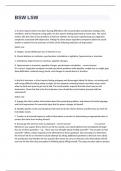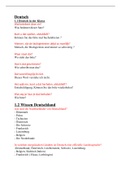BSW LSW
2: A client reports that he has been having difficulties with concentration and decision making, feels
worthless, and has frequent crying spells. He also reports feeling depressed on some days. The social
worker asks the client a few questions to find out whether he has been experiencing any vegetative
symptoms associated with depression. Asking the client about vegetative symptoms allows the social
worker to explore for the presence of which of the following indicators of depression?
Select one:
A. Fatigue, social withdrawal, loss of interest in sex.
B. Mental dullness or confusion, psychomotor retardation or agitation, hypersomnia or insomnia.
C. Anhedonia, hypersomnia or insomnia, appetite changes.
D. Hypersomnia or insomnia, appetite changes, psychomotor retardation. - correct answer
D is correct: Vegetative symptoms include persistent problems with appetite, weight loss or weight gain,
sleep difficulties, reduced energy levels, and changes in sexual desire or function.
In the first interview, a client reports feeling unhappy and discouraged about his future, not eating well,
and having difficulty falling asleep at night. He has stopped contacting friends and often misses work
when he feels too upset to get out of bed. The social worker suspects that the client may be self-
destructive. Given that this is the first interview, how should the social worker proceed with her
assessment?
Select one:
A. Engage the client, gather information about the presenting problem, and observe his body language
and facial expressions for nonverbal signs that he poses a danger to himself.
B. Identify specific events and situations that have led to the client's distress and find ways to meet his
immediate needs.
C. Conduct a structured inquiry to collect information as a basis for determining an appropriate plan to
protect the client from hurting himself.
D. Encourage the client to enter a psychiatric - correct answer C is correct:
Whenever you suspect that a client is at risk for suicide, you should address this immediately through
the use of direct questions - e.g., "Have you ever thought about hurting yourself?" "Do you plan to hurt
yourself?" When a client responds in the affirmative to these questions, the next step is to determine
the level of risk for an imminent suicide attempt by asking additional questions to find out more about
his suicide plan and whether he has acquired the means to carry out the plan; this information will tell
you how far the client has proceeded in thinking about killing himself. The steps you then take to protect
,the client should be consistent with the level of risk currently posed by the client. The risk to life is
highest when a client has both a lethal suicide plan and the means available to carry it out.
Which of the following diagnoses cannot be given to an individual who is under the age of 18 years?
Select one:
A. Borderline personality disorder.
B. Antisocial personality disorder.
C. Dissociative identity disorder.
D. Erectile disorder. - correct answer B is correct: Antisocial personality
disorder is one of the few diagnoses which, by definition, cannot be given to a person who is younger
than age 18. A minor who displays characteristic signs of antisocial personality disorder would receive a
diagnosis of conduct disorder.
A client is taking medication to control the symptoms of a mental disorder. Because of the potential
side-effect of a serious blood disorder, she is required to have a blood test every week. The client is
MOST likely taking which of the following medications?
Select one:
A. Clozaril.
B. Chlorpromazine.
C. Clonazepam.
D. Celexa. - correct answer A is correct: The atypical (second-generation)
antipsychotic clozapine (Clozaril) was introduced in the United States in 1990. In clinical trials, this
medication was found to be more effective than conventional (first-generation) antipsychotic
medications in individuals with treatment-resistant schizophrenia (schizophrenia that had not
responded to other drugs) and the risk of tardive dyskinesia was lower. However, because of the
potential side-effect of a serious blood disorder - agranulocytosis (loss of the white blood cells that fight
infection) - individuals who are on clozapine must have a blood test every one or two weeks.
From the perspective of operant conditioning theory, which of the following statements is the BEST
illustration of negative reinforcement?
Select one:
A. Eat your peas and you can watch television.
B. If you do the crime, you must pay the fine.
, C. If you study hard, you will pass the test.
D. If you take out the garbage, I will stop yelling at you. - correct answer D is
correct: By definition, reinforcement increases the behavior that it follows. Negative reinforcement
involves removing a stimulus (in this case, yelling) in order to increase the frequency of a response (in
this case, taking out the garbage).
The client is a 24-year-old woman who gave birth to a premature boy four months ago. She reports
getting little prenatal care while pregnant with her son and smoking cigarettes during her pregnancy.
Her son weighed about 4 pounds when he was born and had fairly low Apgar scores. He remained in the
hospital for two months but now lives at home with the client and her boyfriend. The client is feeling
anxious about motherhood because her first child, who was fussy but seemed healthy, died at age 5
months. This information suggests that the new baby is MOST at risk for which of the following?
Select one:
A. Nonorganic failure to thrive.
B. Colic.
C. SIDS.
D. Down syndrome. - correct answer C is correct: Sudden infant death
syndrome (SIDS) refers to the unexpected death of an infant for which no physical cause can be found.
The cause of SIDS is unknown but certain risk factors have been identified, many of which are described
in this question: In terms of infant risk factors, SIDS occurs more often in male infants, low-birth-weight
infants, premature infants, infants with low Apgar scores, infants who sleep on their stomachs, and
infants with a sibling who previously died of SIDS. Maternal risk factors include young age, low
socioeconomic status, smoking, drug abuse during pregnancy, closely spaced pregnancies, and
inadequate prenatal care.
A social worker meets with a 30-year-old client who recently divorced her husband. The couple has two
children who are living with the client and see their father every other weekend. The client reports
feeling exhausted now that she has to care for the children by herself. In assessing this situation, the
social worker should be aware that, according to research, in the initial period following divorce, a
custodial mother is MOST likely to:
Select one:
A. use more authoritarian but less consistent punishment.
B. believe she is an inadequate parent. C. be overly permissive.
D. expect her ex-husband to discipline the children. - correct answer A is
correct: Following divorce, parents experience emotional distress and changes in functioning that often
include a "diminished capacity to parent" (Wallerstein & Blakeslee, 1990): The mother, who usually has
physical custody of the children, is frequently socially isolated and lonely and experiences a decline in





